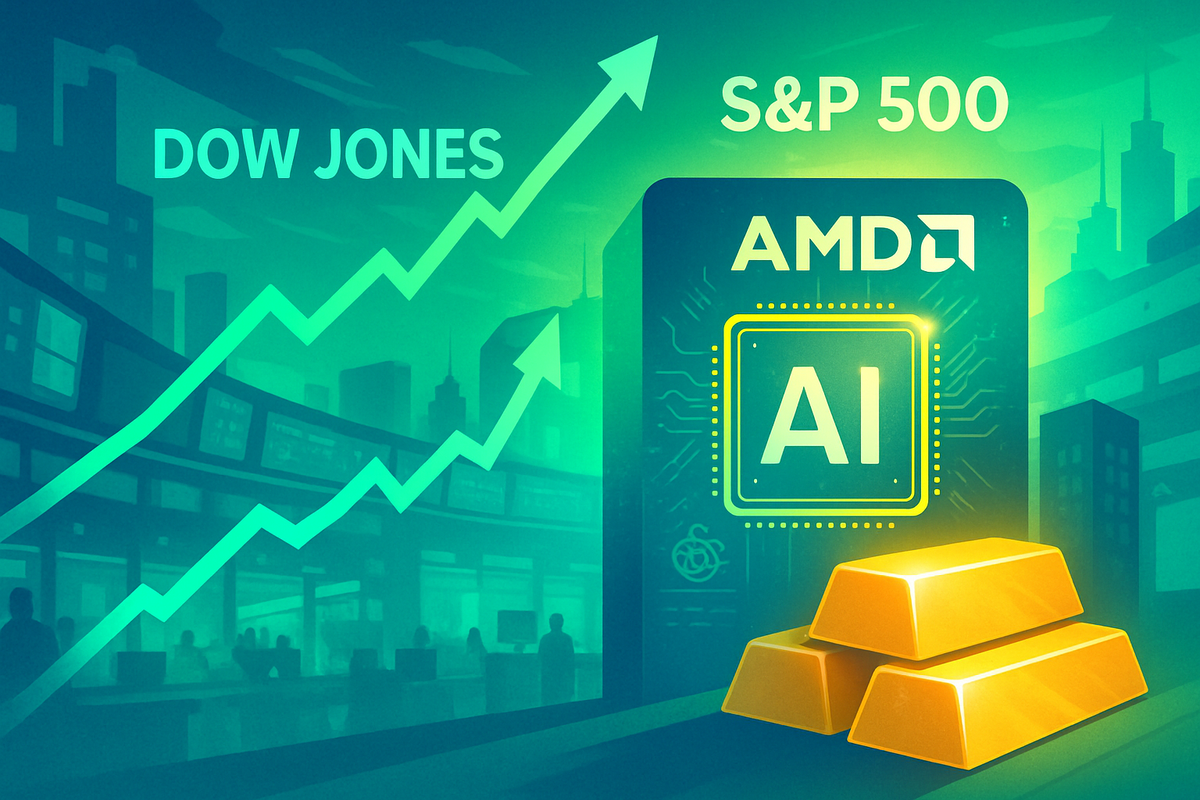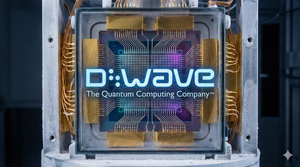
In a remarkable display of market dynamism, the Dow Jones Industrial Average and the S&P 500 have achieved their longest winning streaks since May, signaling robust investor confidence amidst a backdrop of technological advancement and shifting economic expectations. This bullish sentiment was significantly amplified by the extraordinary performance of Advanced Micro Devices (NASDAQ: AMD), whose stock soared to unprecedented levels following a landmark partnership with OpenAI. Concurrently, gold, the perennial safe-haven asset, has continued its ascent, shattering previous records and surpassing the $3,900 per ounce mark, reflecting persistent global economic uncertainties and geopolitical tensions.
This confluence of events paints a complex yet exciting picture for investors. The simultaneous rally in equity markets and gold suggests a nuanced interpretation of economic signals, where technological innovation and potential monetary easing fuel optimism, while underlying concerns drive demand for traditional hedges. The current market environment, as of October 6, 2025, is characterized by a significant re-evaluation of growth sectors, particularly artificial intelligence, alongside a flight to safety, indicating a delicate balance between risk-on and risk-off sentiments.
A Triple Crown for the Markets: Streaks, Surges, and Shiny Records
The recent market activity has been nothing short of historic. The S&P 500, a key barometer of U.S. economic health, recorded a significant 9-day winning streak ending May 2, 2025, its longest since 2004. This rally was fueled by positive comments regarding tariffs from the White House, despite some weak consumer confidence data, and bolstered by strong Q1 earnings from major tech players like Nvidia (NASDAQ: NVDA) and Meta Platforms (NASDAQ: META). Further reinforcing this trend, the S&P 500 also achieved a six-day winning streak concluding on July 28, 2025, and another by October 3, 2025, the latter driven predominantly by massive investments in artificial intelligence and the anticipation of further interest rate cuts by the Federal Reserve. Even a U.S. government shutdown, which delayed economic data releases in late September and early October, failed to dampen investor enthusiasm, leading some analysts to describe a "no news matters" mentality in the market's ascent.
The most dramatic individual corporate story unfolded on October 6, 2025, with Advanced Micro Devices (NASDAQ: AMD). The semiconductor giant's stock experienced an explosive surge, with pre-market trading reports indicating jumps of over 20% to 30%. This propelled AMD shares well above their previous 52-week high, reaching prices between $202.30 and $210.08 per share and adding approximately $60 billion to its market capitalization. The catalyst for this unprecedented rise was the announcement of a multi-year strategic agreement with OpenAI, a leading AI research and deployment company. The deal involves OpenAI deploying up to 6 gigawatts of AMD's cutting-edge Instinct graphics processing units (GPUs), with OpenAI potentially acquiring up to a 10% ownership stake in AMD. This partnership is a monumental win for AMD, positioning it as a core strategic partner for OpenAI and a formidable contender in the rapidly expanding AI infrastructure market, where it has historically trailed its rival, Nvidia.
Simultaneously, gold has continued its relentless climb, establishing multiple new record highs throughout 2025. On September 3, 2025, gold reached $3,549.40 per ounce, only to be surpassed on September 29, 2025, when it broke above $3,800 per ounce for the first time. The rally culminated on October 6, 2025, as spot gold surged past $3,900, hitting $3,910.09 per ounce, with COMEX gold futures reaching an all-time high of $3,949.07 USD/t.oz. This sustained bullish trend, marking seven consecutive weeks of gains, has been fueled by a confluence of factors: persistent economic uncertainty, heightened geopolitical tensions driving safe-haven demand, expectations of interest rate cuts by the U.S. Federal Reserve making non-yielding assets more attractive, a weakening U.S. dollar, aggressive buying by central banks seeking to diversify reserves, and ongoing inflation concerns. The U.S. government shutdown further amplified safe-haven demand, contributing to gold's meteoric rise.
Navigating the Winners and Losers in a Shifting Landscape
The recent market movements have created clear beneficiaries and posed new challenges for various public companies. Leading the charge as a definitive winner is Advanced Micro Devices (NASDAQ: AMD). Its strategic partnership with OpenAI is a game-changer, solidifying its position as a critical player in the burgeoning AI chip market. This deal not only promises substantial revenue streams from the deployment of its Instinct GPUs but also validates AMD's technological prowess and strategic vision in a sector previously dominated by Nvidia (NASDAQ: NVDA). While Nvidia remains a formidable force, AMD's surge signals intensified competition, potentially impacting Nvidia's market share and future growth trajectory in the AI segment.
The broader technology sector, particularly companies involved in artificial intelligence, cloud computing, and advanced semiconductors, stands to benefit from the bullish sentiment driving the S&P 500's streaks. Companies like Microsoft (NASDAQ: MSFT), Google (NASDAQ: GOOGL), and Amazon (NASDAQ: AMZN), which are heavily invested in AI infrastructure and services, could see continued investor interest. However, the increased focus on AMD might divert some investment flows from other players.
On the other hand, the record-breaking surge in gold prices has been a boon for gold mining companies. Major players such as Barrick Gold (NYSE: GOLD) and Newmont (NYSE: NEM) are likely experiencing increased profitability due to higher realized prices for their output. This upward trend in gold could also positively impact exchange-traded funds (ETFs) and other investment vehicles tied to precious metals, attracting more capital from investors seeking safe-haven assets or inflation hedges. Conversely, companies whose business models are adversely affected by economic uncertainty or a weakening dollar, or those in sectors that typically underperform during periods of heightened safe-haven demand, might face headwinds.
Broader Implications and Historical Parallels
These recent market events are deeply intertwined with broader industry trends and economic narratives. AMD's breakthrough partnership with OpenAI underscores the accelerating Artificial Intelligence revolution, highlighting the immense and growing demand for high-performance computing infrastructure. This event signals a maturation of the AI chip market, moving beyond a single dominant player towards a more competitive landscape, which could foster further innovation and drive down costs in the long run. The ripple effects extend to the entire technology ecosystem, from data center operators to software developers, all of whom rely on powerful hardware.
The sustained winning streaks of the Dow and S&P 500, despite intermittent economic concerns and a government shutdown, reflect a prevailing optimism driven by technological progress and the anticipation of supportive monetary policy. This "tech-led bull market" dynamic has historical precedents in periods like the late 1990s, where innovation drove significant market gains. However, the simultaneous surge in gold prices introduces a layer of complexity, indicating that while growth narratives are strong, underlying economic uncertainty and geopolitical risks remain significant concerns for investors. This dual rally suggests a market hedging its bets, seeking both growth and protection.
Regulatory and policy implications are also significant. The Federal Reserve's stance on interest rates remains a critical factor. Expectations of rate cuts have been a key driver for both equity markets (by making borrowing cheaper and boosting corporate earnings potential) and gold (by reducing the opportunity cost of holding non-yielding assets). Any deviation from these expectations could trigger significant market reactions. Furthermore, the U.S. government shutdown, while seemingly shrugged off by equity markets, undoubtedly amplified safe-haven demand for gold, demonstrating how political instability can directly influence asset prices. Historically, gold rallies during periods of high inflation or geopolitical turmoil, and the current environment aligns with these patterns, with 2025 shaping up to be gold's best year since 1979.
The Road Ahead: Opportunities and Challenges
Looking ahead, the short-term market outlook suggests continued volatility tempered by strong underlying trends. For AMD, the immediate future involves executing on the OpenAI partnership and demonstrating its ability to scale production of Instinct GPUs to meet demand. The company will be closely watched for further AI-related announcements and its competitive stance against Nvidia. The broader equity markets will likely continue to be influenced by upcoming economic data, corporate earnings reports, and, crucially, signals from the Federal Reserve regarding its monetary policy path. Any definitive timeline or indication of interest rate cuts could provide further impetus for the Dow and S&P 500.
In the long term, the AI sector is poised for exponential growth, presenting immense opportunities for companies positioned at the forefront of hardware and software innovation. AMD's strategic pivot and success in this domain could redefine its market standing for years to come. For gold, the sustained high prices suggest a persistent demand for safe-haven assets, indicating that global economic and geopolitical uncertainties are unlikely to dissipate quickly. This could lead to a re-evaluation of gold's role in diversified portfolios, potentially solidifying its position as a core asset for risk mitigation.
Potential strategic pivots for companies include further investment in AI research and development, supply chain optimization to meet burgeoning demand for advanced chips, and hedging strategies for investors seeking to balance growth with protection against market downturns. Market opportunities may emerge in ancillary services supporting the AI ecosystem, such as advanced cooling solutions for data centers or specialized AI software. Challenges include intense competition, potential supply chain disruptions, and the inherent unpredictability of macroeconomic factors. Investors should prepare for scenarios where market enthusiasm for AI could lead to overvaluations, or where unexpected economic shocks could trigger corrections.
Concluding Thoughts: A Market in Transition
The recent confluence of events – the Dow and S&P 500's extended winning streaks, AMD's monumental surge driven by its OpenAI partnership, and gold's record-breaking ascent – signifies a market in a profound state of transition. Key takeaways include the undeniable acceleration of the AI revolution, positioning companies like AMD at the forefront of a new technological paradigm. Simultaneously, the persistent demand for gold underscores a deep-seated caution among investors regarding global economic stability and geopolitical risks, even amidst bullish equity market performance.
Moving forward, the market will likely be characterized by a fascinating interplay between these contrasting forces. Investors should closely monitor the execution of major AI partnerships, particularly AMD's collaboration with OpenAI, as these will be critical indicators of future growth in the technology sector. The Federal Reserve's monetary policy decisions, especially regarding interest rates, will continue to exert a powerful influence on both equity and precious metals markets. Furthermore, geopolitical developments and their potential impact on global supply chains and economic sentiment will remain crucial watchpoints.
Ultimately, these events highlight a market that is both innovative and risk-aware, capable of rewarding groundbreaking technological advancements while simultaneously seeking refuge in traditional safe havens. The lasting impact will likely be a more diversified and dynamic technology landscape, with AMD emerging as a formidable challenger in the AI chip arena, and gold cementing its role as an indispensable hedge in an uncertain world.
This content is intended for informational purposes only and is not financial advice.





